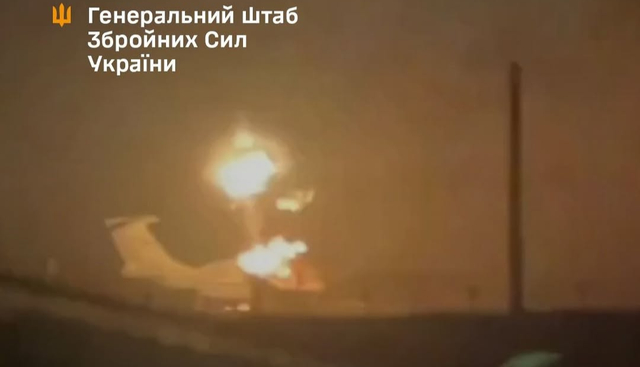
In an ambitious, complex strike operation simultaneously hammering targets hundreds of kilometers apart, dozens of Ukrainian drones and missiles overnight Monday-Tuesday hit and damaged a Russian military airfield, a bomber repair plant, a kamikaze drone factory, a high-tech air defense unit and a pair of oil refineries.
The long-range air raids carried out by Bars jet-propelled drones, Neptune cruise missiles and unnamed propeller-driven drones struck facilities in the Russian Azov Sea port city Taganrog, the Black Sea port city Novorossiysk, and the Black Sea port city Tuapse, a Ukrainian General Staff Tuesday morning statement said.
JOIN US ON TELEGRAM
Follow our coverage of the war on the @Kyivpost_official.
In Taganrog, according to sources reviewed by Kyiv Post, drones and possibly missiles struck and damaged the Beriev TANTK aircraft plant, a repair facility for long-range Tu-95MS (NATO: “Bear”) bombers and Beriev A-50 AEW&C (airborne early warning and command) surveillance planes. The independent Russian news agency Astra reported explosions and large-scale fires on those facilities’ premises.
The Ukrainian weapons came in low and from seaward (south-west), local news reports said. According to unconfirmed Ukrainian milblogger reports, up to six Bear bombers were inside the TANTK aircraft plant for repairs and upgrades, at the time of the Ukrainian attack.
Local social media showed major fires in progress. Ukraine’s UNIAN news agency citing local news feeds reported Taganrog’s Atlant Aero drone manufacturing company also was attacked.
Other Topics of Interest
Russian Drone Slams Into Moldovan House; Romanian F-16s Scrambled After Airspace Breach
Russian drones crossed into Moldova and Romania during a mass strike on Ukraine – one crashed onto a Moldovan home, while Romania scrambled fighter jets after detecting multiple airspace violations.
At least one drone or missile struck an A-60 AEW&C air surveillance plane – the Russian version of the US apex sky watch AWACS system on board the E-3 Sentry aircraft – parked at the east end of the runway at Taganrog military airport, detonating fuel stored aboard the aircraft and igniting a billowing fire.
Independent aircraft watch group identified the plane by the tail number RA-86879, an experimental aircraft used for testing the latest Russian air surveillance radars. Images of the aircraft going up in flames as fuel aboard exploded made probable the plane was a total write-off.
The An-60 is an upgraded version of Russia’s Soviet-era A-50 air surveillance plane, an aircraft packed with electronics and costing between $300-$500 million. The An-50 and its upgraded version A-50U are used daily by the Russian air force for aerial surveillance and battle management in combat operations in Ukraine. The Armed Forces of Ukraine (AFU) had prioritized attacks against the surveillance platform, which is no longer in production.
Taganrog regional authorities in early morning Monday statements said that “drone debris” falling after successful intercepts by air defense forces struck production facilities, and informed local residents damage was minimal and authorities had the situation under control.
There was no mention of the AEW&C plane or damage to the bomber plant or the drone factory. Three civilians were killed and at least ten treated for injuries, a Taganrog city administration statement made public on Tuesday afternoon said.
Video, photographs and personal accounts of fires, explosions and flames billowing over the Taganrog airfield at the same time flooded local social media. OSINT research groups quickly geo-located the content to Taganrog military airfield. One set of images, confirmed to be recent video of the base, showed the An-60 burning fiercely.
Probably more than “slight damage due to falling drone debris.” NASA world-wide satellite fire overwatch shows two major blazes burning fiercely at a military airfield in the Russian city Taganrog, hours after a Ukrainian missile and drone strike. The fire on the runway is likely a burning Russian AEW&C plane. The fire near the runway is a facility used by the Russian air force to repair Tu-95MS (NATO designation: “Bear”) bombers. The Kremlin attacks Ukrainian homes and businesses with cruise missiles launched by Bear bombers once or twice a week. (Kyiv Post screen grab of NASA’s real-time world-wide online fire map as of 12:00 Kyiv time on Tuesday.)
NASA world-wide FIRMS satellite fire surveillance system shows two major blazes burning fiercely in Taganrog hours after the Ukrainian strike. One fire on the runway appeared co-located with the Russian AEW&C plane. The second fire was at the location of the bomber repair facility. Approaching publication of this article, FIRMS may have revealed an unknown variant of the Il-76 that was also damaged.
Contradicting early official declarations of an ineffective Ukrainian strike, by mid-morning on Tuesday later the Rostov regional military command, the civil defense agency responsible for territory around the Sea of Azov including Taganrog, imposed a state of emergency on the city, Taganrog mayor Sevetlana Kambulova said in a statement.
The General Staff statement said that a second strike package attacked the Sheskharis oil terminal in Novorossiysk, and a third drone-missile salvo hit the Tuapse oil refinery on the Black Sea shore. Video recorded from the deck of a Turkish tanker awaiting access to the Novorossiysk terminal recorded long-range Russian air defense missiles fired at a possible airborne target. The strikes most distant from probable Ukrainian launch sites traveled between 450-500 km via a direct flight vector.
Prior to the Taganrog strike, on Monday evening, reported a wave of propeller-driven Ukrainian drones flew into airspace in the vicinity of Novossiysk. Local social media captured images of dense anti-aircraft fire and red, green and white tracers flying in multiple directions over Novorossiysk bay.
The fusillade included automatic cannon, machine guns, automatic rifles and anti-aircraft missiles. In one widely-shared video of the engagements, a probable Russian Pantsyr is launched, appears to lose its target, and flies across a bay to strike and detonate against the wall of an apartment building in the seaside resort village of Gelendzhik.
Novorossiysk in April 2023 became the main base of Russia’s Black Sea Fleet (BSF), following Kremlin general abandonment of the Black Sea Fleet’s traditional base in the Ukrainian Crimean port city Sevastopol. Since then Russian naval and air defense authorities have been sensitive to Armed Forces of Ukraine (AFU) attacks against Novorossiysk potentially threatening Russia’s last warship base on the Black Sea, and concentrated dense air defenses there.
Hours before the Taganrog strike took place, the Astra news agency reported citing local media, Ukrainian drone targeted and possibly damaged a major air defense complex near Novorossiysk city manned the Russian Armed Forces 51st Air Defense Division. The powerful unit Ukrainian military intelligence statements is equipped with Pantsyr short-range air defense missiles, and S-300 air defense interceptor missiles, and Russia’s top-of-the-line S-400 air defense system. Ukraine’s General Staff later confirmed S-400 systems had been targeted.
Novrossiysk authorities reported all Ukrainian drones were shot down but one “falling” drone hit a city apartment building.
The Ukrainian RBK-Ukraina news service, citing government sources, claimed a Russian amphibious assault warship tied up at Novorossiysk port was damaged in the Monday-Tuesday strike, but Kyiv Post couldn’t confirm that report. Russia’s fleet started the war against Ukraine with six Orsk-class amphibious assault warships. Currently two are known to still be afloat, one in Sevastopol and the other in Novorossisyk.
Major Robert Brovdi, commander of Ukraine’s Unmanned Strike Forces (USF) in a Tuesday statement credited the USF’s 14th Special Operations Regiment and 414th Brigade for carrying out the attacks, which he claimed were successful and would be followed up. A still image published by his command showed a night-vision image of a drone boring in on the Tuapse oil refinery. Battle damage assessments were still in progress, a USF statement said.
“Gasoline is becoming a scarce liquid in the swamps (an impolite Ukrainian euphemism for Russia) and gas and oil burn quickly,” Brovdi said. “This was a courtesy visit.”
Ukrainian strike planners have since 2023 increasingly used the tactic of targeting Russian air defense systems covering a particular area with the objective of forcing those systems off-line by damage or need to shift locations, a few days or even hours before launching a precision attack at a high-value target the air defense unit was supposed to protect.
With a reported range of 400 kilometers, the S-400 system based around Novorossiysk is a key element of Russian air defense network covering the both the western Black Sea coast and the Sea of Azov, where Taganrog is located.
Video, photographs, social media comment reviewed by Kyiv Post found no evidence of long-range missiles’ or air defense systems more sophisticated than Kalashnikov rifles defending the Taganrog airfield overnight Monday-Tuesday, possibly implying Ukrainian strikes had disabled those defenses earlier. The AFU prior to Tuesday had attacked the Beriyev TANTK aircraft plant at least four times with drones.
In a pair of strikes launched on March 1 and March 9, an initial wave of Ukrainian drones attacked air defenses around the plant, and the follow-up wave targeted aircraft on the ground and the repair plant.
One A-50 AEW&C parked on the tarmac was confirmed damaged in those air raids with, possibly, additional bombers damaged inside the repair plant.





